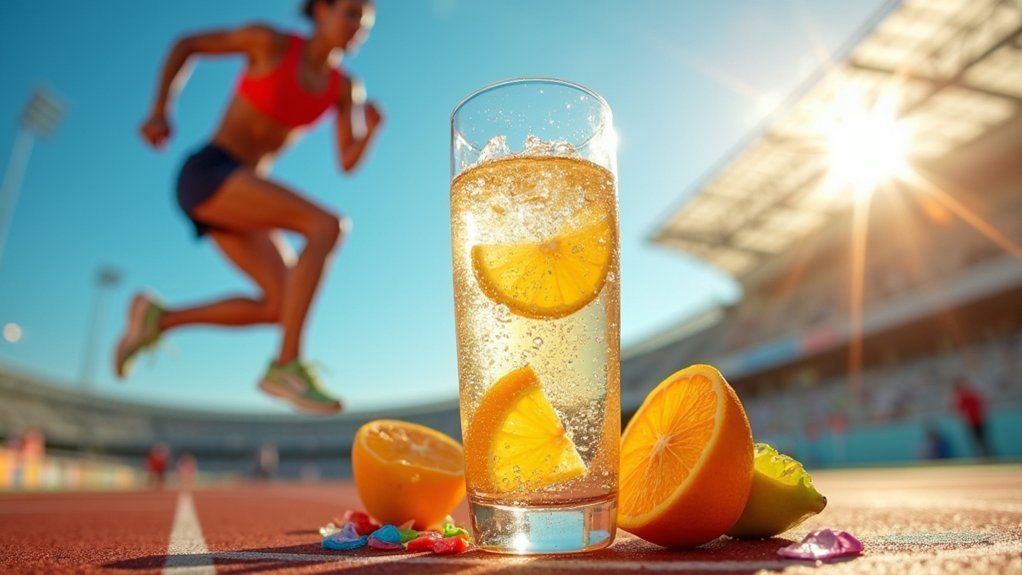After trampoline workouts, your body needs proper fluid replenishment. For sessions under an hour, water works fine, but longer jumps require electrolyte drinks. Aim for a 4:1 carb-to-protein ratio recovery drink within 30-60 minutes post-exercise. Room-temperature fluids absorb faster than cold ones. Don’t wait—rehydrate immediately after dismounting, sipping regularly during the first half hour. The right recovery strategy transforms muscle fatigue into renewed strength faster than you’d expect.
Why Trampoline Workouts Demand Specialized Recovery Fluids

While traditional workouts require adequate hydration, trampoline exercises create unique physiological demands that standard water simply can’t address. Each bounce triggers intensified lymphatic movement through gravitational pumping, rapidly clearing toxins while depleting essential electrolytes.
Your body experiences specialized stress during rebounding that water alone can’t remedy. The repetitive g-force loading strains collagen structures and depletes glycogen faster than steady-state cardio. The lymphatic system detoxification benefits from rebounding workouts increase your body’s need for minerals that support this natural cleansing process.
Rebounding creates unique structural demands, accelerating collagen stress and glycogen depletion beyond what typical exercise produces.
Meanwhile, your cells expel wastes at accelerated rates, creating micronutrient deficiencies. The acid-base balance shifts dramatically during high-intensity rebounding intervals, requiring alkaline solutions to neutralize lactate buildup.
You’ll need precise electrolyte ratios mimicking interstitial fluid composition to maintain ideal lymph valve function and prevent dehydration from the increased lymphatic flow your trampoline session creates.
Optimal Hydration Strategies for High-Impact Rebounding Sessions
Developing a precise hydration protocol transforms your trampoline workouts from depleting to energizing. Time your fluid intake strategically—drink 30 minutes before bouncing and sip every 10-15 minutes during your session.
For workouts under an hour, plain water works perfectly, but longer sessions require electrolyte replacement. Room-temperature fluids absorb faster than ice-cold options, supporting ideal lymphatic flow during your rebounding routine. Proper hydration helps transport and flush out toxins and waste that are released during rebounding as your lymphatic system is activated.
Always adjust your hydration approach based on:
- Intensity level (high-intensity bouncing requires sodium-added fluids)
- Environmental conditions (increase intake by 20-30% in heat/humidity)
- Session duration (hourly intake prevents dehydration during extended workouts)
Monitor your urine color—pale straw indicates proper hydration—ensuring your lymphatic system functions efficiently during and after your rebounding routine.
Electrolyte Replenishment: The Key to Bounce-Back Performance

Bouncing back from an intense trampoline workout depends largely on replenishing the critical electrolytes lost through sweat.
Your body’s sodium, potassium, and magnesium levels directly impact muscle function and recovery.
Electrolytes aren’t optional—they’re mission-critical for turning your post-trampoline muscle fatigue into renewed strength.
Aim to consume electrolytes within 30-60 minutes post-jump when your body absorbs nutrients most efficiently. For sessions exceeding an hour, prioritize drinks containing 500-700mg/L of sodium plus potassium. The timing of your electrolyte intake significantly affects your recovery efficiency after demanding jump workouts.
Don’t dilute your system with water alone—this can flush out remaining electrolytes.
Sports drinks provide the fastest replenishment, but natural alternatives work too: bananas for potassium, a pinch of salt in citrus water for sodium, or coconut water for moderate recovery needs.
Watch for warning signs like muscle cramps, dizziness, or unusual fatigue—they’re your body’s way of signaling electrolyte depletion.
Protein-Carbohydrate Drinks That Support Muscular Recovery After Jumping
Beyond electrolytes alone, your post-trampoline recovery demands a strategic combination of protein and carbohydrates to rebuild muscle and replenish energy stores.
Research shows a 4:1 carb-to-protein ratio effectively reduces muscle damage markers while enhancing performance gains for subsequent workouts.
- A 20g protein threshold stimulates muscle protein synthesis, while the carbohydrates trigger insulin response that accelerates nutrient delivery.
- Liquid formulations empty from your stomach faster than solids, making them ideal during short recovery windows between jump sessions.
- Carb-protein combinations can reduce CPK levels (muscle damage markers) by up to 83% compared to carb-only drinks.
For HIIT-style jumping workouts, these formulations particularly benefit same-day double sessions and multi-day events by combating cumulative fatigue and supporting consistent performance.
Skipping proper post-jump nutrition can lead to Low Energy Availability and reduced performance capacity in subsequent training sessions.
Timing Your Post-Trampoline Fluid Intake for Maximum Benefit

Precisely when you consume fluids after trampolining can dramatically impact your recovery rate and performance benefits. For ideal results, hydrate immediately after dismounting the trampoline when your body is primed to absorb nutrients and replenish losses.
You’ll want to weigh yourself before and after intense sessions to calculate fluid needs—aim to drink 24 ounces for each pound lost.
Continue sipping regularly during the first 30 minutes post-workout, then maintain consistent hydration throughout the day.
Don’t wait until you’re thirsty; by then, you’re already dehydrated. Instead, establish a post-jump routine of immediate hydration followed by steady intake.
This approach guarantees your body recovers quickly, reduces inflammation, and prepares you for your next bouncing session with maximum energy. Consider incorporating sports drinks with electrolytes during particularly intense training sessions to help maintain proper fluid balance in your system.
Frequently Asked Questions
Can Children Use the Same Recovery Drinks as Adults After Trampoline Workouts?
No, you shouldn’t give children adult recovery drinks. Water is best for most kids’ trampoline sessions, while diluted juice or milk provides better nutrition than commercial adult recovery products with unnecessary ingredients.
How Do Recovery Needs Differ Between Indoor and Outdoor Trampoline Sessions?
You’ll need faster hydration outdoors (within 15-20 minutes) than indoors (30 minutes). Outdoor sessions require electrolyte-rich fluids while water works for shorter indoor workouts. Temperature and humidity affect both your fluid needs and absorption rates.
Are There Recovery Fluids Specifically Designed for Professional Trampoline Athletes?
Yes, you’ll find specialized fluids like Wilderness Athlete’s electrolyte formula with 4:1 carb-protein ratios, BCAAs, and L-glutamine specifically designed to address the unique recovery needs of professional trampoline athletes’ high-intensity jumping demands.
Will Caffeine in Post-Workout Drinks Affect Sleep After Evening Trampoline Sessions?
Yes, caffeine will disrupt your sleep after evening trampoline sessions. It blocks adenosine, delays sleep onset, reduces sleep quality, and can worsen recovery. Avoid caffeinated drinks within 6 hours of bedtime for ideal rest.
Can Certain Fluids Help Reduce Joint Impact From Rebounding Exercises?
Yes, you’ll reduce joint impact by drinking tart cherry juice (reduces inflammation), coconut water (natural electrolytes), and Fluid Recovery mix with L-glutamine. Pair with collagen peptides and stay well-hydrated for ideal synovial fluid maintenance.
In Summary
You’ll see faster recovery when you choose the right post-trampoline fluids. Drink electrolyte-rich beverages immediately after your session to replace what you’ve lost through sweat. Within 30 minutes, add a protein-carbohydrate mix to repair muscles strained during high-impact rebounding. Don’t underestimate hydration’s role in your performance—your next bounce depends on it. Remember, proper fluid timing is just as essential as your workout itself.





Leave a Reply